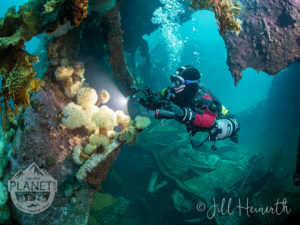
A blossom in the scar of the torpedo hole.
In 2016, I embarked on the Royal Canadian Geographical Society’s Expedition of the Year: The Hidden Geography of Newfoundland. This project documented little-known history when the Battle of the Atlantic arrived on North American shores. On two separate raids, U-boats sunk four vessels in Newfoundland waters and destroyed a loading pier for the strategic Bell Island iron ore mine. Recently, I received first-hand confirmation regarding rumors surrounding the involvement of a spy in the sinking of the vessels Saganaga and Lord Strathcona.
Newfoundland resident Lloyd Walker reached out to me to describe an encounter he had as a young boy while playing in the woods at Topsail Beach. While playing with his friends, the group of boys discovered a small clearing in the woods filled with things they could only imagine from comic books. A lean-to and fire pit were constructed in a glade littered with discarded tin cans. Lengthy wires draped from tree to tree and connected to a radio perched on a shelf. As they approached the equipment, a stranger in a dark turtleneck sweater and a dog chased them through the woods. Pursued beyond the woods and into a field, the man threw rocks striking one boy on the ankle. Finally reaching a road, the terrified children were picked up by a car and taken to report their experience to the Canadian Army field station in Topsail Beach. At that moment, nobody knew that the SS Saganaga and Lord Strathcona had just been sunk by torpedos fired from the U-boat 513 captained by Rolf Ruggeberg and that 29 men had lost their lives in the attack. The following day, the boys were interviewed again, and a strange man was picked up on Black Head Road.
Today the wrecks still reveal new clues about the past, but I have much happier memories than Lloyd Walker, who still bristles at the sight of a big black dog. As I perch my camera to take a shot of the location where a torpedo ripped open the hull of the PLM 27, I marvel at the delicate beauty of the sea anemones. A bouquet adorns the scar, beautifying the very spot where the ocean poured into the hull. We cannot forget the sacrifice that so many made during WWII. Soldiers, sailors, rescuers, and families still carry the weight of the fall of 1942, when Bell Island Newfoundland lost its innocence.
